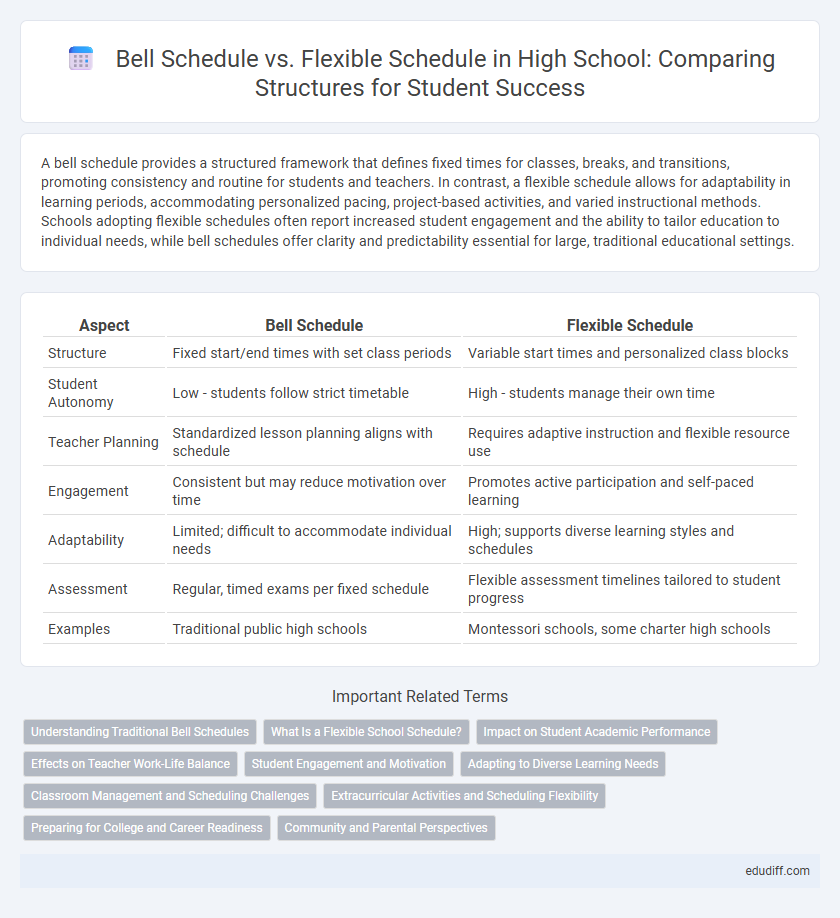A bell schedule provides a structured framework that defines fixed times for classes, breaks, and transitions, promoting consistency and routine for students and teachers. In contrast, a flexible schedule allows for adaptability in learning periods, accommodating personalized pacing, project-based activities, and varied instructional methods. Schools adopting flexible schedules often report increased student engagement and the ability to tailor education to individual needs, while bell schedules offer clarity and predictability essential for large, traditional educational settings.
Table of Comparison
| Aspect | Bell Schedule | Flexible Schedule |
|---|---|---|
| Structure | Fixed start/end times with set class periods | Variable start times and personalized class blocks |
| Student Autonomy | Low - students follow strict timetable | High - students manage their own time |
| Teacher Planning | Standardized lesson planning aligns with schedule | Requires adaptive instruction and flexible resource use |
| Engagement | Consistent but may reduce motivation over time | Promotes active participation and self-paced learning |
| Adaptability | Limited; difficult to accommodate individual needs | High; supports diverse learning styles and schedules |
| Assessment | Regular, timed exams per fixed schedule | Flexible assessment timelines tailored to student progress |
| Examples | Traditional public high schools | Montessori schools, some charter high schools |
Understanding Traditional Bell Schedules
Traditional bell schedules in high schools segment the day into fixed periods with designated start and end times, creating a structured environment for classes and transitions. This schedule optimizes classroom management and ensures consistent instructional time, supporting standardized routines for students and teachers. Understanding the rigidity of bell schedules highlights the differences compared to flexible schedules, which allow varied timings and personalized learning paces.
What Is a Flexible School Schedule?
A flexible school schedule allows students to customize their learning hours and course load to fit individual needs, promoting autonomy and personalized education. Unlike the traditional bell schedule with fixed start and end times, flexible schedules may include staggered classes, asynchronous learning options, and varied attendance patterns. This adaptability supports diverse learning styles and helps improve student engagement and academic performance.
Impact on Student Academic Performance
Bell schedules create a structured environment that supports consistent study routines and timely class transitions, positively influencing student academic performance by reducing distractions. Flexible schedules allow personalized learning paces, which can enhance understanding and retention for students who thrive with autonomy but may challenge those needing more guidance. Research indicates that a balance between structured time and flexibility often leads to improved focus, engagement, and overall academic achievement.
Effects on Teacher Work-Life Balance
A traditional bell schedule structures the school day into fixed periods, often leading to rigid teaching times and limited flexibility for educators to manage personal and professional responsibilities. Flexible schedules allow teachers to adjust their work hours and lesson planning, contributing to improved work-life balance by accommodating individual needs and reducing stress. Studies show that flexible scheduling correlates with higher job satisfaction and decreased burnout among high school teachers.
Student Engagement and Motivation
Bell schedules structure high school days with fixed periods, promoting routine that can enhance student focus but may limit personalized pacing and intrinsic motivation. Flexible schedules allow students to choose when to attend certain classes or engage in activities, fostering greater autonomy, increased engagement, and motivation by catering to individual learning preferences. Research shows that flexible scheduling often leads to higher student participation and improved academic outcomes through tailored learning environments.
Adapting to Diverse Learning Needs
A flexible schedule in high schools allows students to learn at their own pace, catering to diverse learning styles and needs more effectively than a traditional bell schedule. Personalized time management supports differentiated instruction and deeper understanding of subjects across various student abilities. Implementing flexible schedules can enhance engagement and academic performance by accommodating individual learning preferences and reducing stress.
Classroom Management and Scheduling Challenges
Bell schedules create a structured environment that simplifies classroom management by establishing consistent start and end times, reducing student confusion and tardiness. Flexible schedules offer adaptability but often result in complex coordination efforts and increased potential for missed classes or overlapping activities. Schools must balance the predictability of bell schedules against the dynamic needs addressed by flexible scheduling to optimize both instructional time and student engagement.
Extracurricular Activities and Scheduling Flexibility
A flexible schedule in high school allows students to allocate more time for extracurricular activities, enhancing participation and skill development outside the classroom. Unlike traditional bell schedules with fixed periods, flexible scheduling adapts to individual needs, reducing conflicts between academic and extracurricular commitments. This adaptability supports better time management and encourages a balanced student lifestyle.
Preparing for College and Career Readiness
A flexible schedule in high school allows students to tailor their learning pace and course selections, fostering time management and self-discipline skills critical for college and career readiness. In contrast, a traditional bell schedule offers structured periods that help develop punctuality and routine, essential for professional environments. Balancing both approaches can enhance adaptability and strengthen competencies needed for successful post-secondary education and workforce integration.
Community and Parental Perspectives
Community members often value bell schedules for their predictability, which supports consistent student routines and facilitates coordination among families. Parents appreciate flexible schedules for allowing personalized learning paces and accommodating extracurricular activities, enhancing student well-being. Both perspectives highlight the importance of balancing structure and adaptability to meet diverse student and family needs in high school settings.
Bell Schedule vs Flexible Schedule Infographic

 edudiff.com
edudiff.com